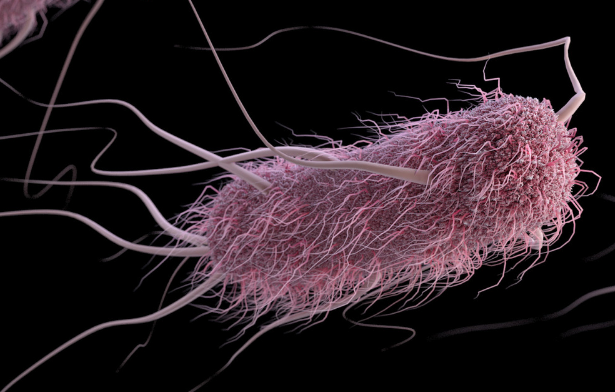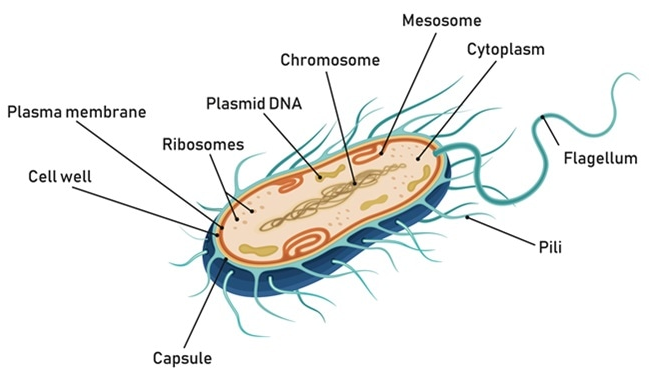
Flagellum is a long, whip-like structure that helps some single-celled organisms move. It is composed of microtubules. Flagella help propel cells and organisms in a whip-like motion. They are found in all three domains of the living world, that is, archaea, bacteria and eukaryote.
Flagella not only provide movement for bacteria but also provide a mechanism for pathogenic bacteria to aid in colonizing hosts and therefore transmitting disease. Flagella use a twist-and-stick method to anchor bacteria onto surface. Flagella also function as bridges or scaffolds for adhesion to host tissue.

Pili are hair-like appendages found on the surface of many bacteria. The pili is used for different purposes in the cell. It is attached on the surface of cells in order to transfer DNA from cell to cell, attach to surfaces or for general cell to cell adhesion. Pili are shorter and thinner than flagella. The formation of pili is controlled by the gene present in plasmids whereas the formation of flagella is controlled by genes present in the nucleoid region of bacteria.
The Difference
- Pili occur on the surface of bacteria and are hair-like tubular microfibers like structure whereas flagella occur on the surface of bacteria and long whip-like filamentous structures.
- The formation of pili is controlled by the gene present in plasmids whereas the formation of flagella is controlled by genes present in the nucleoid region of bacteria.
- Pili are only present in Gram-negative bacteria whereas Flagella is present in both Gram positive and Gram-Negative bacteria.
- The length and thickness of flagella are about 15 µm long and 15-20nm in diameter whereas the length and width of pili is about 0.2-20 µm and 3-10nm in diameter.
- Flagella are comparatively thicker than pili.
- Pili are less rigid when compared to flagella.
- The main function of pili is gene transfer (by conjugation and attachment). On the other hand, the main function of flagella is locomotion. Some act as the sensory organ.
- Pili are randomly distributed on the surface of bacteria whereas flagella have a distinct pattern of distribution. Distribution may be lateral or throughout the surface.
- Example of bacteria having pili include: pseudomonas, Neisseria gonorrhoeae, Shigella, salmonella, Myxococcus Xanthus, Escherichia coli etc. On the other hand, examples of bacteria having flagella include: Helicobacter,vibrio cholera, pylori, salmonella typhimurium etc.
- Pili is made up of pilin protein in its structure whereas flagella are made up of flagellin protein in its structure.
- Pili are external in their origin, they originate from the cell wall of bacteria whereas flagella are internal in their origin, and they originate from the cytoplasmic membrane.
- There are two types of pili, that is, conjugative and type IV. On the other hand, there three types of flagella, that is, bacterial, eukaryotic and archaeal.
- Pili are straight and non-helical in nature whereas flagella are non-straight in nature.
- Usually there is no motor system associated with pili, however, flagella are usually associated with a complex motor system at the base for propulsion.
- Twitching motility is the motion mode exhibited by pili especially type IV pili whereas flagella exhibit an undulating sinusoidal motion.
- Pili are comparatively shorter than flagella.
Also Read: The Structural Difference between Cilia and Microvilli
Difference Between Flagella and Pili In Tabular Form
| BASIS OF COMPARISON | PILI | FLAGELLA |
| Structural Orientation | Pili occur on the surface of bacteria and are hair-like tubular microfibers like structure. | Flagella occur on the surface of bacteria and long whip-like filamentous structures. |
| Shape | Pili are straight and non-helical in nature. | Flagella are non-straight in nature. |
| Formation | The formation of pili is controlled by the gene present in plasmids. | The formation of flagella is controlled by genes present in the nucleoid region of bacteria. |
| Presence | Pili are only present in Gram-negative bacteria. | Flagella is present in both Gram positive and Gram-Negative bacteria. |
| Length And Width | The length and width of pili is about 0.2-20 µm and 3-10nm in diameter | The length and thickness of flagella are about 15 µm long and 15-20nm in diameter. |
| Width Description | Pili are comparatively thinner than flagella. | Flagella are comparatively thicker than pili. |
| Rigidity | Pili are less rigid when compared to flagella. | Flagella are comparatively more than rigid than pili. |
| Main Function | The main function of pili is gene transfer (by conjugation and attachment). | The main function of flagella is locomotion. Some act as the sensory organ. |
| Distribution | Pili are randomly distributed on the surface of bacteria. | Flagella have a distict pattern of distribution. Distribution may be lateral or throughout the surface. |
| Examples | Example of bacteria having pili include: pseudomonas, Neisseria gonorrhoeae, Shigella, salmonella, Myxococcus Xanthus, Escherichia coli etc | Examples of bacteria having flagella include: Helicobacter, vibrio cholera, pylori, salmonella typhimurium etc. |
| Protein In Structure | Pili is made up of pilin protein in its structure. | Flagella are made up of flagellin protein in its structure. |
| Point Of Origin | Pili are external in their origin, they originate from the cell wall of bacteria. | Flagella are internal in their origin, and they originate from the cytoplasmic membrane. |
| Types | There are two types of pili, that is, conjugative and type IV. | There three types of flagella, that is, bacterial, eukaryotic and archaeal. |
| Motor System | There is no motor system associated with pili. | Flagella are usually associated with a complex motor system at the base for propulsion |
| Motility | Twitching motility is the motion mode exhibited by pili especially type IV pili. | Flagella exhibit an undulating sinusoidal motion. |
| Length | Pili are comparatively shorter than flagella. | Flagella are comparatively longer than pili. |
Comments are closed.